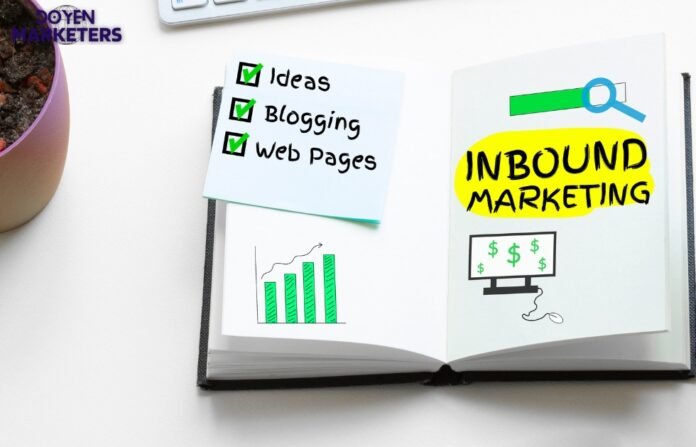Social media has become an integral part of inbound marketing. Inbound marketing is a strategy that focuses on attracting customers through relevant and helpful content. Social media platforms offer a unique opportunity to connect with potential customers and engage with them on a personal level. By leveraging social media, businesses can create a strong brand presence and establish themselves as thought leaders in their industry.
Social media has a significant impact on inbound marketing. It allows businesses to reach a wider audience and generate more leads. Social media platforms provide a platform for businesses to showcase their products and services and engage with their customers. By creating valuable content that resonates with their target audience, businesses can attract potential customers and build long-term relationships with them.
Key Takeaways
- Social media is an important part of inbound marketing as it allows businesses to connect with potential customers and engage with them on a personal level.
- Social media platforms provide a unique opportunity for businesses to showcase their products and services and establish themselves as thought leaders in their industry.
- By creating valuable content that resonates with their target audience, businesses can attract potential customers and build long-term relationships with them.
The Role of Social Media in Inbound Marketing
Table of Contents
- 1 The Role of Social Media in Inbound Marketing
- 2 The Impact of Social Media Platforms on Inbound Marketing
- 3 Creating a Successful Social Media Strategy for Inbound Marketing
- 4 The Intersection of SEO and Social Media in Inbound Marketing
- 5 Measuring Success in Social Media Inbound Marketing
- 6 Frequently Asked Questions
- 6.1 How can social media help attract and engage potential customers?
- 6.2 What role does social media play in building relationships with customers?
- 6.3 What are some ways social media can be used to conduct market research?
- 6.4 How can social media amplify the reach of inbound marketing efforts?
- 6.5 What are some potential drawbacks of not having a social media strategy?
- 6.6 How can social media metrics be used to measure the success of inbound marketing campaigns?
- 7 Conclusion
Social media has become an integral part of inbound marketing, as it provides a platform for businesses to attract, engage, and convert their target audience. In this section, we will discuss the different ways in which social media plays a crucial role in inbound marketing.
Social Media as a Tool for Attraction
Social media platforms such as Facebook, Twitter, LinkedIn, and Instagram have billions of active users every day. This makes them an excellent tool for businesses to attract potential customers. By creating engaging content, such as blog posts, infographics, videos, and images, businesses can capture the attention of their target audience and encourage them to visit their website.
Moreover, social media allows businesses to leverage the power of hashtags, which can help them reach a wider audience. By using relevant hashtags in their posts, businesses can attract people who are interested in their products or services.
Engaging the Target Audience on Social Media
Social media is also an excellent platform for businesses to engage with their target audience. By responding to comments and messages, businesses can build a relationship with their customers and create a sense of community.
Furthermore, social media allows businesses to conduct polls, surveys, and contests, which can help them gather valuable feedback and insights from their audience. This information can be used to improve their products or services and create a better customer experience.
Converting Leads through Social Media
Finally, social media can also be used to convert leads into customers. By sharing customer testimonials, case studies, and product demos, businesses can demonstrate the value of their products or services and encourage potential customers to make a purchase.
Moreover, social media allows businesses to retarget their website visitors with ads, which can help them convert leads into customers. By showing relevant ads to people who have already shown an interest in their products or services, businesses can increase their chances of making a sale.
In conclusion, social media plays a crucial role in inbound marketing by providing businesses with a platform to attract, engage, and convert their target audience. By leveraging the power of social media, businesses can create a strong online presence and build a loyal customer base.

The Impact of Social Media Platforms on Inbound Marketing
Social media has become an essential part of inbound marketing strategies. It provides businesses with a platform to engage with their audience, build brand awareness, and drive traffic to their website. In this section, we will explore the impact of different social media platforms on inbound marketing.
Instagram and Inbound Marketing
Instagram is a visual platform that has gained immense popularity in recent years. It allows businesses to showcase their products or services in a visually appealing way, and engage with their followers through comments, direct messages, and stories. Instagram can be used to create brand awareness, drive traffic to a website, and generate leads.
Facebook’s Influence on Inbound Marketing
Facebook is the largest social media platform with over 2.8 billion monthly active users. It provides businesses with a platform to create a business page, engage with their audience through comments, direct messages, and posts. Facebook can be used to build brand awareness, generate leads, and drive traffic to a website.
Twitter and LinkedIn’s Role in Inbound Marketing
Twitter and LinkedIn are both platforms that are popular among professionals. Twitter is a platform that allows businesses to engage with their audience through short and concise messages. LinkedIn is a platform that allows businesses to connect with professionals and showcase their products or services. Both platforms can be used to build brand awareness, generate leads, and drive traffic to a website.
The Power of YouTube in Inbound Marketing
YouTube is a video-sharing platform that has over 2 billion monthly active users. It provides businesses with a platform to create video content, engage with their audience through comments, and drive traffic to their website. YouTube can be used to build brand awareness, generate leads, and drive traffic to a website.
Emerging Platforms: Snapchat, Pinterest, and TikTok
Snapchat, Pinterest, and TikTok are emerging platforms that are gaining popularity among younger audiences. Snapchat allows businesses to create short-lived content that disappears after 24 hours. Pinterest is a platform that allows businesses to showcase their products or services through images. TikTok is a platform that allows businesses to create short-form video content. These platforms can be used to build brand awareness and engage with younger audiences.
In conclusion, social media platforms have a significant impact on inbound marketing. They provide businesses with a platform to engage with their audience, build brand awareness, and drive traffic to their website. By utilizing different social media platforms, businesses can create a comprehensive inbound marketing strategy that meets their business goals.
Creating a Successful Social Media Strategy for Inbound Marketing
Creating a successful social media strategy for inbound marketing is essential to attract, engage, and convert potential customers into loyal followers. A well-designed social media strategy can help you build brand awareness, drive traffic to your website, and generate leads that can be nurtured into sales. Here are some key components to consider when developing your social media strategy.
Understanding Your Audience
The first step in creating a successful social media strategy is to understand your audience. You need to know who your target audience is, what they are interested in, and where they spend their time online. This information will help you create content that resonates with your audience and engage with them on social media platforms they prefer.
Content Creation and Quality Content
Creating quality content is a crucial part of your social media strategy. Your content should be informative, engaging, and relevant to your audience. You can create a content calendar to plan your posts in advance and ensure that you are providing a consistent flow of content to your followers. You can also use different types of content such as videos, images, infographics, and blog posts to keep your audience engaged.
Promoting Your Brand and Services
Social media is an excellent platform to promote your brand and services. You can use social media to showcase your products, services, and brand personality. You can also use social media to share customer success stories, industry news, and other relevant content that showcases your expertise.
Engaging with Followers and Building Trust
Engaging with your followers is a critical component of your social media strategy. You need to respond to comments, messages, and mentions promptly. You can also use social media to build trust with your audience by providing valuable information, sharing your expertise, and being transparent about your business practices.
Advertising and Paid Social Media Ads
Paid social media ads can help you reach a broader audience and drive traffic to your website. You can use paid social media ads to promote your products, services, and events. You can also use paid social media ads to retarget people who have visited your website or engaged with your brand on social media.
In conclusion, creating a successful social media strategy for inbound marketing requires a deep understanding of your audience, quality content creation, promoting your brand and services, engaging with followers, and advertising and paid social media ads. By implementing these components, you can build a strong social media presence that attracts, engages, and converts potential customers into loyal followers.

The Intersection of SEO and Social Media in Inbound Marketing
Social media and SEO are two essential components of inbound marketing. They work together to drive website traffic, improve search engine rankings, and leverage social shares for SEO. In this section, we’ll explore how social media and SEO intersect in inbound marketing.
Driving Website Traffic through Social Media
Social media platforms are an excellent way to drive traffic to your website. By sharing your content on social media, you can reach a broader audience and attract new visitors to your site. Social media also allows you to engage with your audience and build relationships with potential customers.
To maximize the impact of social media on your website traffic, you should:
- Share your content regularly on social media platforms.
- Optimize your social media profiles for search.
- Use hashtags to increase the visibility of your posts.
- Engage with your audience and encourage them to share your content.
Improving Search Engine Rankings
Search engine optimization (SEO) is the practice of improving your website’s visibility in search engine results pages (SERPs). Social media can play a significant role in improving your search engine rankings.
When people share your content on social media, it creates backlinks to your website. Backlinks are a critical factor in search engine rankings. The more high-quality backlinks you have, the higher your website will rank in search results.
To improve your search engine rankings with social media, you should:
- Share high-quality content that people will want to share.
- Encourage people to share your content on social media.
- Monitor your backlinks and remove any low-quality or spammy links.
Social shares can also directly impact your website’s SEO. When people share your content on social media, it signals to search engines that your content is valuable and relevant. This can lead to higher search engine rankings and increased visibility in search results.
To leverage social shares for SEO, you should:
- Make it easy for people to share your content on social media.
- Use social share buttons on your website and blog.
- Monitor your social shares and engage with people who share your content.
- Encourage people to share your content by offering incentives or rewards.
In conclusion, social media and SEO are two essential components of inbound marketing. By leveraging the intersection of social media and SEO, you can drive website traffic, improve search engine rankings, and grow your business.

Measuring Success in Social Media Inbound Marketing
To determine the effectiveness of your social media inbound marketing, you need to measure its success. Measuring success is a crucial step in creating a successful social media strategy. Here are some key metrics to consider when measuring your social media inbound marketing efforts.
Understanding Analytics and ROI
Analytics is a critical component of social media inbound marketing. It helps you understand how your social media efforts are performing and how they are impacting your business. By analyzing your social media analytics, you can identify which posts are performing well and which ones are not. You can also determine which social media platforms are driving the most traffic to your website.
Return on Investment (ROI) is another essential metric to consider when measuring the success of your social media inbound marketing. ROI measures the return you receive on the investment you make in your social media marketing efforts. To calculate ROI, you need to compare the cost of your social media marketing efforts to the revenue generated from those efforts.
Tracking Conversions and Sales Funnel Metrics
Conversions are actions that people take after seeing your social media content. These actions can include signing up for a newsletter, filling out a form, or making a purchase. Tracking conversions is crucial because it helps you understand how your social media content is influencing your audience.
Sales funnel metrics are also essential to track when measuring the success of your social media inbound marketing. Sales funnel metrics track how many people are moving through your sales funnel and how quickly they are doing so. By tracking these metrics, you can identify areas where your sales funnel needs improvement.
Evaluating Brand Awareness and Exposure
Brand awareness and exposure are critical metrics to consider when measuring the success of your social media inbound marketing. Brand awareness measures how familiar people are with your brand, while exposure measures how many people are seeing your social media content.
To evaluate brand awareness and exposure, you can track metrics like reach and engagement. Reach measures how many people are seeing your social media content, while engagement measures how many people are interacting with your content.
In conclusion, measuring the success of your social media inbound marketing is essential to creating a successful social media strategy. By tracking metrics like analytics, ROI, conversions, sales funnel metrics, brand awareness, and exposure, you can determine how your social media efforts are performing and make necessary adjustments to improve your results.
Frequently Asked Questions
Social media can be a powerful tool to attract and engage potential customers because it allows businesses to reach a large audience quickly and easily. By creating and sharing valuable content, businesses can establish themselves as thought leaders in their industry and build trust with their audience. Social media also allows businesses to engage with their audience directly, responding to comments and messages and building relationships with potential customers.
Social media plays a crucial role in building relationships with customers because it allows businesses to connect with their audience on a personal level. By engaging with customers on social media, businesses can show that they care about their customers and are willing to listen to their feedback. This can help build brand loyalty and increase customer retention.
Social media can be a valuable tool for conducting market research because it allows businesses to gather feedback from their audience quickly and easily. By monitoring social media conversations and analyzing social media metrics, businesses can gain insights into their audience’s preferences, needs, and pain points. This information can be used to improve products and services and create more effective marketing campaigns.
Social media can amplify the reach of inbound marketing efforts by allowing businesses to share their content with a wider audience. By creating and sharing valuable content on social media, businesses can attract new followers and increase their reach. Social media also allows businesses to engage with influencers and other thought leaders in their industry, which can help increase their visibility and credibility.
Not having a social media strategy can limit a business’s ability to reach and engage with potential customers. Without a social media presence, businesses may miss out on opportunities to connect with their audience and build brand awareness. Additionally, not having a social media strategy can make it difficult to monitor and respond to customer feedback, which can damage a business’s reputation.
Social media metrics can be used to measure the success of inbound marketing campaigns by providing insights into the effectiveness of content and engagement strategies. By analyzing metrics such as likes, shares, and comments, businesses can determine which types of content resonate with their audience and adjust their strategies accordingly. Social media metrics can also be used to track the growth of a business’s social media following and the impact of social media on website traffic and lead generation.
Conclusion
In conclusion, social media is an essential part of inbound marketing. By using social media, you can reach out to your target audience in a more personalized way, build brand awareness, and create a loyal following of customers.
Social media is also an excellent way to drive traffic to your website and generate leads. By sharing valuable content and engaging with your followers, you can attract potential customers and encourage them to visit your website.
Furthermore, social media provides valuable insights into your audience’s behavior and preferences. By analyzing your social media metrics, you can gain a better understanding of what your audience likes and dislikes, and adjust your marketing strategy accordingly.
Overall, social media is a powerful tool that can help you grow your business and connect with your audience in a meaningful way. By incorporating social media into your inbound marketing strategy, you can stay ahead of the competition and reach your business goals.















